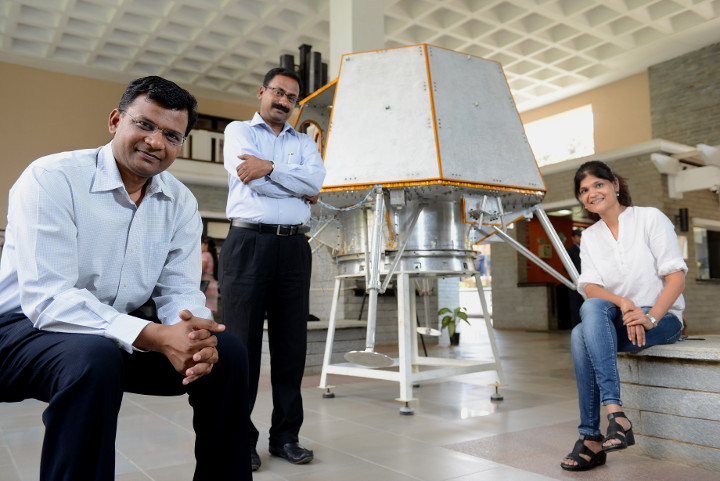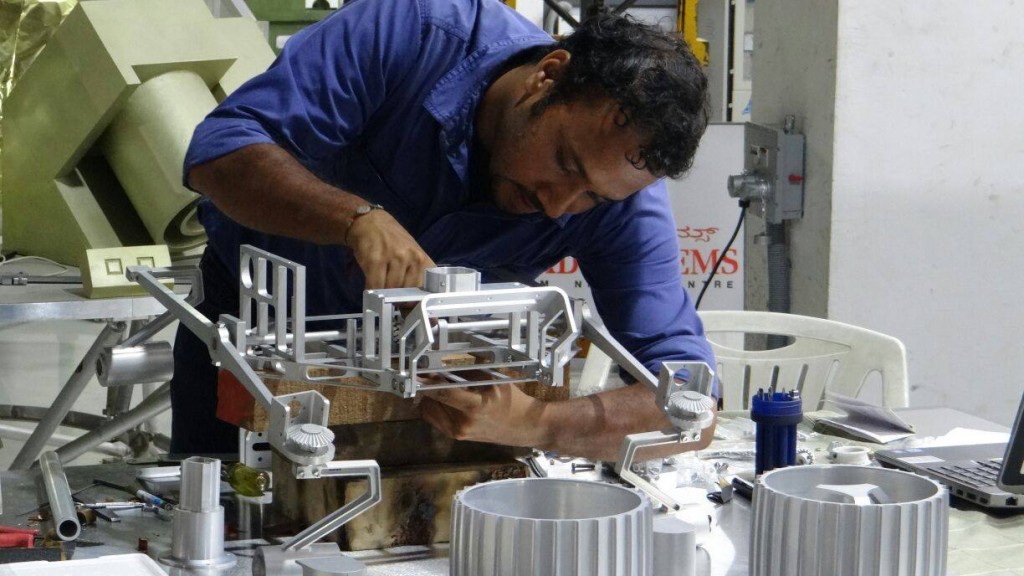One doesn’t automatically think of India when it comes to Space but Google’s US$30 million prize could certainly skyrocket India to the forefront of the Space Race.
The Google Lunar XPrize goes to the first privately-funded team to land on the moon, travel at least five hundred metres, and then transmit high-definition real-time video “Mooncasts” back to earth – all before 31st December 2017.
From sixteen global teams, Team Indus is India’s only hope of winning the multi-million dollar prize at this Global Space Race, and they haven’t disappointed, winning a Milestone Prize: the Landing Prize, pocketing a total of US$1 million in winnings so far.
But India’s growing space sector hasn’t slowed as they have announced plans to certify approximately 5,20,000 trainees and groom 6,000 trainers over a 10 year period by the newly constituted Indian Aerospace and Aviation Sector Skill Council (AASSC).

L-R) Rahul Narayan – TeamIndus Fleet Commander, Ramnath Babu – TeamIndus Jedi Master | Structures, Sheelika Ravishankar – TeamIndus Jedi Master | People Capital with a prototype lander that will land on the moon, and send data and photos back to earth. For Ramnath’s story, shoot happened on 10.04.15, pic by hemant Mishra/mint
Thirty courses are to be introduced over the first three years to ensure greater relevance of skills in the aerospace sector battling for talent in various disciplines according to AASSC Chairman T Suvarna Raju.
“We have signed the term sheet with NSDC (National Skill Development Corporation) covering project objectives, segments, target training trades and broad executive plan,”
“We also have a challenge to set up new institutes and centres of excellence. As an immediate step, we have now decided to appoint a CEO of AASSC,” Raju says.
The registering of the AASSC is just another step taken by India’s impressive Space program.
The Indian Space Research Organisation (ISRO) completed the cheapest ever mission to Mars after successfully launching its latest rocket in September last year.
The testing of its Geostationary Launch Vehicle (GSLV) took US$400 million and a decade to develop but marked a significant breakthrough in sending Indian astronauts into space.
India also made history when its Mars Orbiter Mission successfully entered orbit and in doing so became the first Asian country to reach the red planet.
Even more remarkable is the cost at which it was done. At a reported US$70 million, it is the least expensive inter-planetary mission ever, and gave India membership of an elite club that previously only the United States, the Soviet Union and Europe had been a part of.
It’s no surprise that India’s triumphant year in space travel had humble beginnings.
In 1962 India decided to go to space when a Thumba, a fishing hamlet near the city of Thiruvananthapuram, became the Rocket Launching Station for atmospheric research. A small church served as the workshop while the adjacent Bishop’s house became its makeshift office while rocket parts were transported by bicycle.
India hasn’t looked back now as it is one of the six largest space agencies in the world with a string of achievements to its credit.
But unlike other Space superpowers India’s space program is rooted in developmental objectives rather than military ambition.
A recent example of this is when Cyclone Phailin battered India’s East Coast in 2013, ISRO satellites provided vital information regarding the cyclone and facilitating the government’s timely evacuation of over one million people.
Alongside the various deep space explorations and positive cultural impacts, ISRO also earns India a hefty revenue too.
In 2012-13, Antrix Corporation, ISRO’s commercial sector, reported US$216 million in revenue which is further expected to grow by 15% this year.
However India’s star-reaching success hasn’t been without setbacks.
ISRO Scientist and author of Mission Mars: India’s Quest for the Red Planet Ajey Lele told The Diplomat that India is still not among the major players in the global space launch market attributing this to two factors.
“One is that India has just one satellite launch site with two operational launch pads, which restricts the number of launches it undertakes to between two and four each year. More importantly India has failed so far to make GSLV a fully operational system,” Lele says.
“ISRO needs to develop the capability to carry heavier satellites and into the geostationary orbit if it is keen to become a serious player in the multi-million dollar global space launch business,” he says.
Operationalising the GSLV will provide India with a larger share of an estimated global market for 1,000 satellite launches by 2020 and eliminate the need to pay foreign space agencies to launch its heavier satellites.
And what do the other players think of India’s achievements in Space?
NASA’s Curiosity Rover sent a “Namaste” tweet to ISRO in congratulations of their Mars achievement.
What of Indians controversy of the money spent on the Space programmes?
Indian female engineer and business consultant Bijal Thakore effectively answered that question in a recent blog.
“The Indian space program is resolute as always in its purpose to contribute both toward economical and social development of its people.”
“An emerging country like India needs to diversify its unique proposition as an international player within technology, and the space program has been an important tool ever since the vision of a future India was forged by its leaders at independence.”
If you like this article you may be interested in “Japanese Whiskey Company to Send Whiskey into Outer Space to See How it Ages”.








